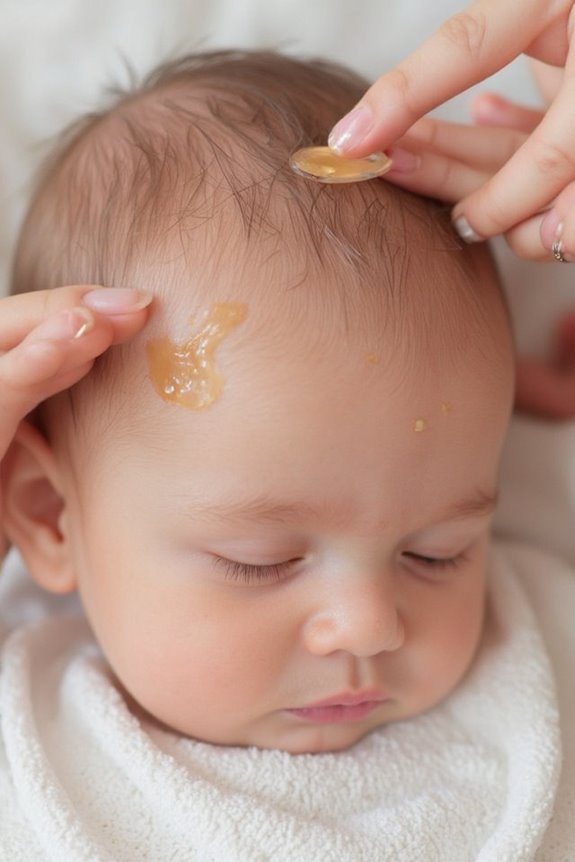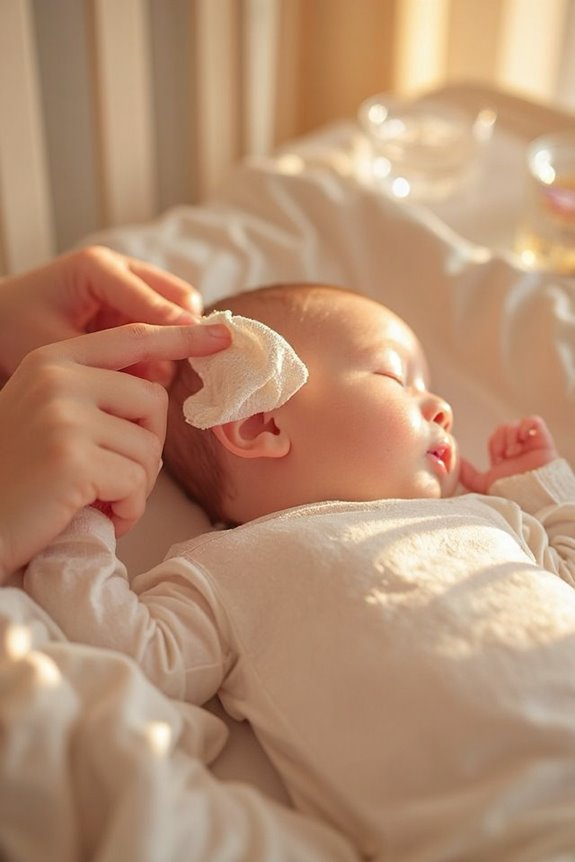Babies don’t actually breathe air in the womb. Instead, they receive oxygen through the placenta, which acts as their lungs, kidneys, and digestive system before birth. Oxygen-rich blood travels from me to my baby through the umbilical cord, while carbon dioxide moves back to my bloodstream for removal. Though fetuses begin practicing breathing movements around week 20 by inhaling amniotic fluid, this is just preparation for life outside. The full process involves remarkable biological adaptations.
Key Takeaways
- Babies don’t breathe air in the womb; oxygen is delivered through the placenta and umbilical cord.
- The placenta acts as the baby’s lungs, exchanging oxygen and carbon dioxide with the mother’s bloodstream.
- Fetal hemoglobin has higher oxygen affinity than adult hemoglobin, enhancing oxygen uptake from maternal blood.
- While not breathing air, fetuses practice breathing movements by inhaling and exhaling amniotic fluid from week 20.
- These breathing movements strengthen respiratory muscles and stimulate lung development before birth.
The Amazing Placenta: The Fetal Lifeline
While you might wonder how a baby breathes inside the womb, the answer lies in one of the most remarkable organs in human development: the placenta. This temporary organ forms gradually during the first trimester, developing from two key layers: the chorion frondosum (fetal contribution) and the decidua basalis (maternal contribution).
The placental structure includes specialized cells called trophoblasts that facilitate the exchange of oxygen, nutrients, and waste between mother and baby—without their blood actually mixing. Beyond being a respiratory substitute, the placenta produces essential placental hormones that:
- Maintain pregnancy
- Support fetal development
- Prepare the mother’s body for birth and breastfeeding
- Regulate amniotic fluid levels
- Provide immune protection
This extraordinary organ effectively serves as your baby’s lungs, digestive system, and kidneys until birth.
Fetal Breathing Movements: Practice Makes Perfect
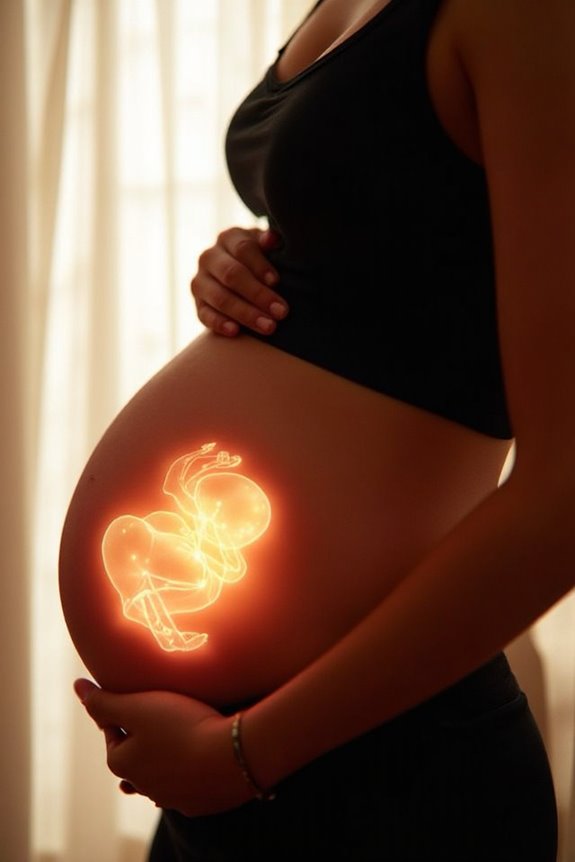
Although babies don’t breathe air in the womb, they’re far from idle when it comes to respiratory development. Starting around week 20-21 of gestation, fetuses begin making respiratory movements, inhaling and exhaling amniotic fluid.
These breathing practice sessions serve significant developmental purposes:
- Strengthening fetal muscle groups needed for respiration after birth
- Supporting the formation of alveoli (air sacs) essential for gas exchange
- Increasing surfactant production to help lungs expand properly
By weeks 24-28, babies practice breathing 10-20% of the time, increasing to 30-40% after week 30. These movements aren’t just exercise—they’re a positive indicator of fetal health and development.
For premature infants, inadequate lung development may require additional medical support until their respiratory systems fully mature.
Oxygen’s Journey: From Mother to Baby
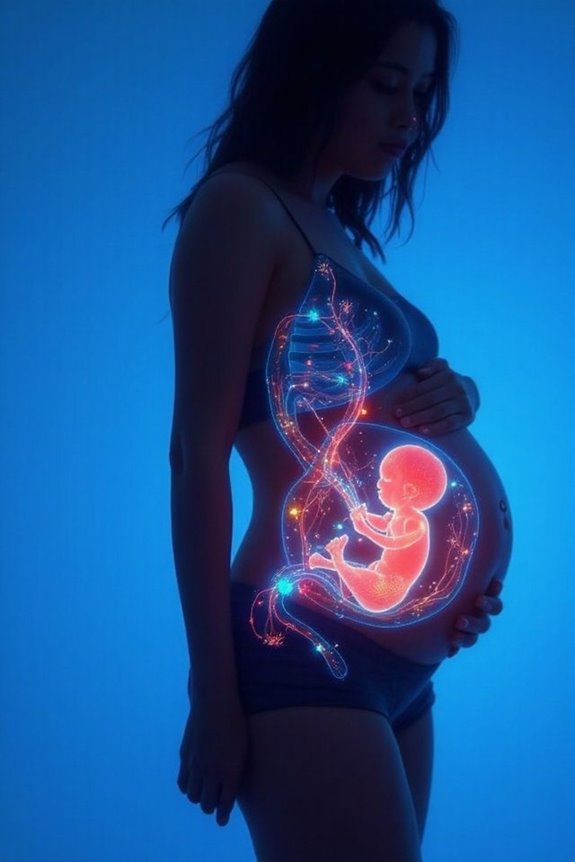
Three essential pathways guarantee your baby receives oxygen while in the womb, despite never taking a single breath of air. Let me explain how this remarkable oxygen transport system works:
- Maternal Blood Supply: Oxygen binds to hemoglobin in your blood, traveling to the placenta where it’s released.
- Placental Transfer: The placenta serves as the exchange interface, allowing oxygen to cross from your bloodstream to your baby’s circulation.
- Fetal Uptake: Your baby’s hemoglobin has a higher affinity for oxygen, efficiently capturing and distributing it throughout developing tissues.
Your maternal health directly impacts this process. Proper nutrition, regular exercise, and avoiding smoking promote ideal oxygen delivery to your developing baby. The efficiency of this system is vital for healthy development of all your baby’s organs and tissues.
Lung Development Before Birth
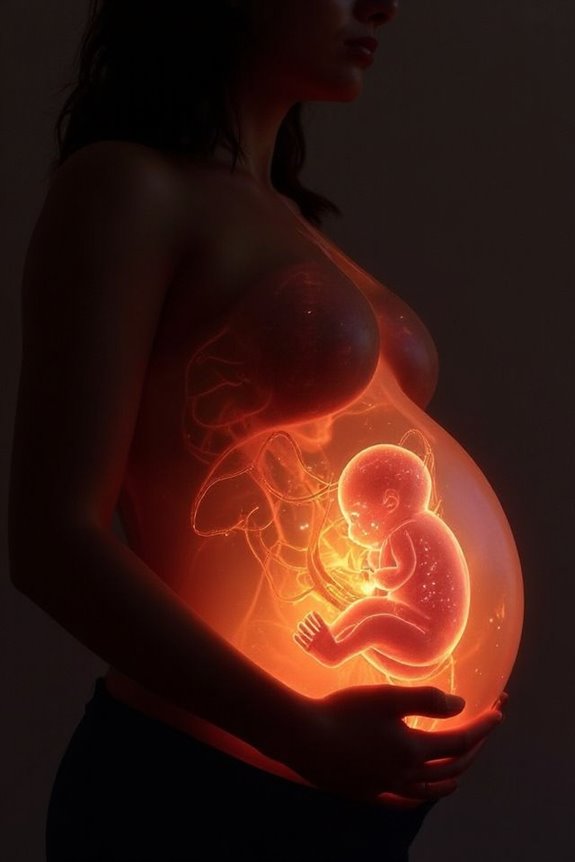
Before your baby takes their first breath, a remarkable process of lung development unfolds inside the womb. This development occurs across five distinct lung stages:
- Embryonic stage (26-33 days): The lung bud forms and branches into two primary bronchi
- Pseudoglandular stage (8-16 weeks): Bronchopulmonary segments develop, but no gas exchange is possible
- Canalicular stage (16-26 weeks): Respiratory bronchioles form, though lungs remain non-functional
- Saccular stage (26-36 weeks): Terminal sacs develop and surfactant production begins
- Alveolar stage (near term to postnatal): Alveoli form, improving lung expansibility
During pregnancy, your baby’s lungs don’t perform gas exchange. Instead, the placenta serves this essential function, with blood bypassing the lungs via the ductus arteriosus. This developmental sequence prepares your baby for that critical first breath at birth.
The Miraculous Transition: From Womb to World
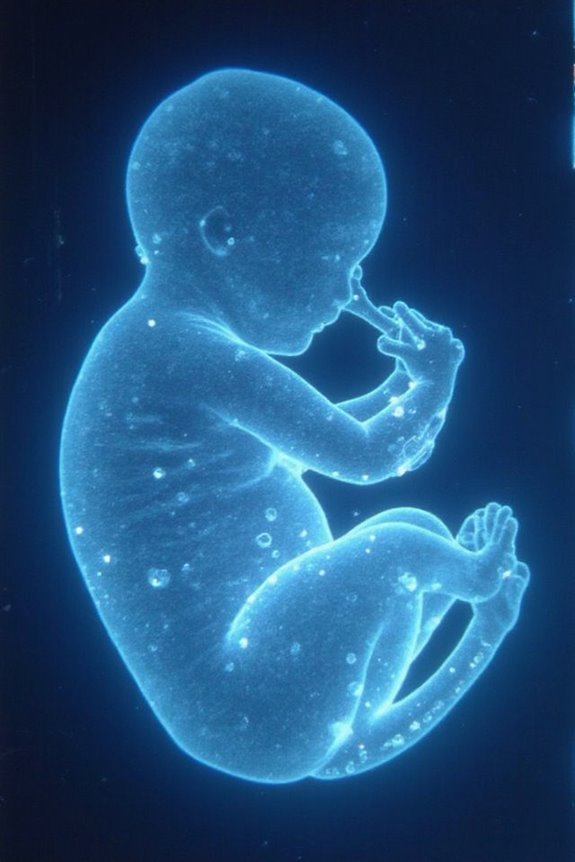
While lung development prepares your baby’s respiratory system, the journey from water-based existence to breathing air represents one of nature’s most remarkable physiological achievements.
In the womb environment, your baby practices breathing by inhaling and exhaling amniotic fluid starting around week 20. These movements strengthen respiratory muscles for birth preparation. During labor, contractions serve two essential purposes:
- Pushing amniotic fluid out of the lungs
- Compressing the thoracic cavity to prepare for inflation
Until the umbilical cord is cut, your baby receives oxygen through the placenta. The first breath after birth:
- Expands previously fluid-filled lungs
- Dramatically increases blood flow to the lungs
- Activates surfactant (produced before birth) to maintain lung expansion
This shift from placental oxygen to independent breathing happens remarkably quickly as your baby adapts to life outside the womb.
Carbon Dioxide Removal in Prenatal Life
As your baby develops inside your womb, they’re constantly producing carbon dioxide (CO₂) as a byproduct of their growing cells’ metabolism. This waste gas must be efficiently removed to prevent dangerous buildup.
CO₂ transport mechanisms
- Your baby’s bloodstream carries CO₂ from their tissues to the placenta
- The umbilical cord contains vessels that transport this CO₂-rich blood
- CO₂ diffuses across the placenta from your baby to your bloodstream
- Your lungs then eliminate this CO₂ when you exhale
If this process becomes impaired through cord compression or placental issues, fetal acidosis risks increase considerably. The accumulation of CO₂ creates an acidic environment that can compromise your baby’s development.
Your increased breathing rate during pregnancy actually helps maintain this crucial exchange system, creating ideal conditions for CO₂ transfer.
Frequently Asked Questions
Can Babies Drown in Amniotic Fluid While in the Womb?
I want to reassure you: babies can’t drown in amniotic fluid while in the womb. They don’t rely on traditional breathing—their fetal respiration happens through the umbilical cord, not their lungs.
Do Twins Share the Same Oxygen Supply in Utero?
Just yesterday, I was thinking about twins! If they share a placenta, they do share an oxygen supply in utero. It’s a fascinating balancing act, with shared blood vessels influencing twin survival through equal oxygen distribution.
Can Maternal Breathing Problems Affect Fetal Oxygen Levels?
Yes, I can confirm that maternal breathing problems directly impact fetal oxygen levels. When my respiratory health is compromised, it reduces oxygen availability for fetal development, potentially causing distress and developmental complications.
When Do Babies First Practice Breathing Movements?
I’ve noticed that babies first practice breathing movements around week 20-21 of pregnancy. These fetal lung development milestones involve inhaling and exhaling amniotic fluid, establishing important prenatal breathing patterns for future respiratory function.
Can a Mother’s Exercise Routine Improve Fetal Oxygen Delivery?
Yes, I’ve found that moderate maternal fitness routines can actually improve placental function and blood flow, enhancing fetal health. However, intense exercise might temporarily reduce oxygen delivery, so balance is key in your routine.



